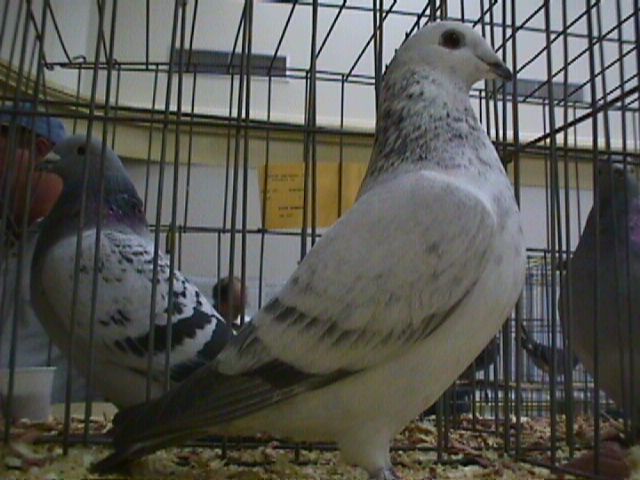

Grizzles come in many colors and forms. You have the standard form which most
grizzle homers are, then Undergrizzle which seems to be a lesser form that
doesn't show much grizzle pattern, White Grizzle which is as the name would
indicate mostly white and you have Tiger Grizzle which looks like a Grizzle
without the grizzle effect in each feather. There is also a form known as Print
Grizzle which is the result of the combination of Undergrizzle, Grizzle and Kite
bronze on a blue colored bird.
Grizzle is a partial dominant with the symbol G. Grizzle which I will refer to here as standard Grizzle removes the pigment from the center shaft outwards. In other words, the birds color is only shown on the outer end tips with the middle being salt and pepper like and the inner most part next to the shaft being white.
This gene is best known for its heterozygous state (G//+) on a blue bared bird. This combination produces the effect which most fanciers call grizzle. When combined with blue check or dark check the bird is much darker and not as appealing. The same is true for the color brown but brown is not as common in racing homers.
When a bird carries this gene twice (G//G), you see more white and less color. This condition on a brown or blue bar results in a bird being stork marked or mostly white with pigmented wing tips and tail. This homozygous state is very similar to the appearance of White Grizzle GW //+ in its heterozygous state. White Grizzle in turn is nearly pure white in it's homozygous state GW//GW.
Normal grizzle is least effected by the bar pattern. Other patterns, dark check, t-pattern and even the modifier spread do have an effect on preventing the lightening effects of grizzle. By that I mean, the darker the pattern or modifier is the lesser the whitened grizzle effect is. A t-pattern blue G//+ would have a grizzle effect around the head and neck as well as in the wing and tail but the t-pattern area would still be t-pattern with only a small amount of grizzle present.
On Ash Red we have a different effect due to Ash red's effects on pigment formation. While Grizzle removes pigment from the center portion of the feather, ash red depletes pigment from the outer portions. The end result in the homozygous G//G; BA// BA state is again a nearly pure white bird with colored eyes normally yellow or red. In the heterozygous state (G//+; BA//BA) the bird is mostly white with some red peppering shown.
Undergrizzle in the heterozygous state (UG//+) has that same salt and pepper look on the inner portion of the feather shaft similar to standard Grizzle but lacks the white look on the body. When the bird is a heterozygous Undergrizzle, blue bar, it still looks like a blue bar with only some grizzle effects when examined up close on the wing and tail feathers. Undergrizzle is an autosomal partial dominant.
There isn't much written on Undergrizzle but Axel Sell does describes it in his book. He says Undergrizzle means a lightening of tail and wing feathers which will only show when the feathers are spread by hand. I have included a photo of a wing taken by my friend Steve Souza. It is one of his blue t-pattern Undergrizzles. Axel Sell goes on to say that it is very common in combination with some piebald markings. He states the inheritance to be recessive or intermediate and that its relationship to the other grizzle factors is not yet known.
If the bird were to carry this gene twice (homozygous UG//UG) which is to be pure for the gene it would show more white with colored tips throughout. As it molted to it's adult plumage, it would become even more white with a sprinkling of pigmented feathers giving it a mottled or Tiger Grizzle look. Unlike Tiger Grizzle that only effects the front portion of the bird, Undergrizzle effects all parts including the wing and tail feathers.
Tiger Grizzle (GT) lacks the salt and pepper effect on the individual feather, but gives the appearance of grizzle due to the mixture of white and colored feathers side by side with more white than color. This gives it the grizzle look without being true Grizzle. Tiger grizzle has normal wing and tail feathers. They lack that grizzle effect. However when in combination with standard grizzle you will produce both conditions at the same time. This combination is common on most Tiger Grizzles. A true Tiger Grizzle will have little to no white on its juvenile plumage but will molt in its white look over the first two years. Remember, a homozygous Undergrizzle will appear as a Tiger Grizzle but will have the white effects in both wing and tail and will not undergo such a dramatic change from its juvenile to adult plumage.
Grizzle
Brown Grizzles
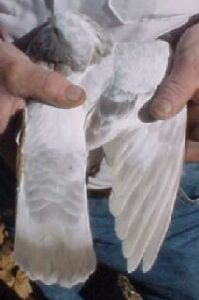
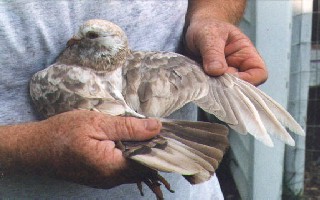
Brown Bar Grizzle left Spread Brown Grizzle right (S//+; b//b; G//+)
Blue/Black Grizzles
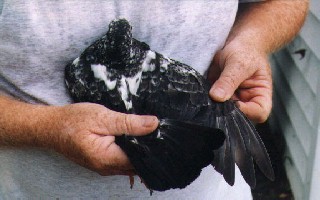
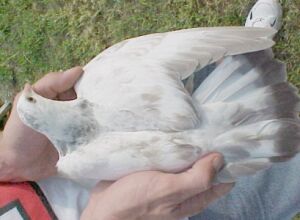
Spread Blue/Black Grizzle. (S//+; +//+; G//+)on the left.
On the right is a dilute blue grizle. Note how similiar it is to a brown
grizzle. Look closley at the tail for a color difference.
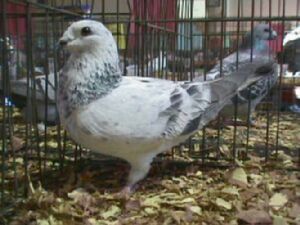
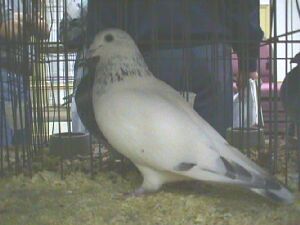
Heterozygous Grizzle (G//+) and Homozygous Grizzle (G//G)
Ash Red Grizzles
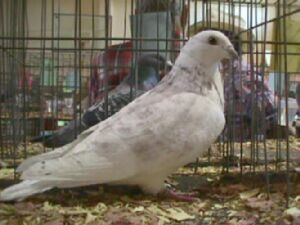
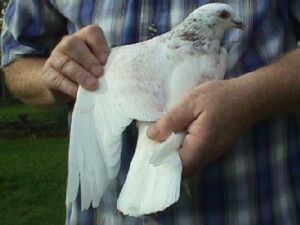
Two ash red, checker pattern, heterozygous grizzles
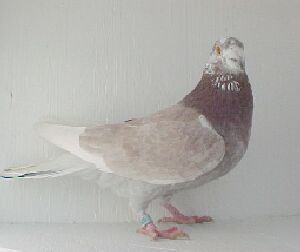

Ash red, t-pattern, heterozygous grizzle left, ash red, bar pattern, heterozygous grizzle right. If these birds were Homozygous for Grizzle (BA//BA; G//G) they would be almost completely white.
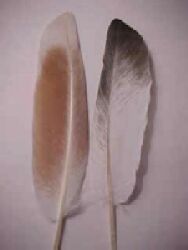
Above are two primary wing feathers. One ash red the other blue grizzle. Note how the grizzle has prevented the formation of pigment along the base outwards while the ash red has done just the opposite. Combine these two genes together and they will work in concert to prevent pigment formation in general. What you end up with is a white feather instead. Thus the ash red grizzle which is nearly pure white with only small amounts of red showing.
Tiger Grizzle
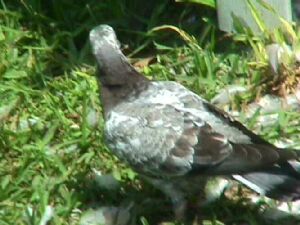
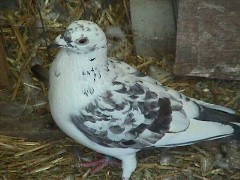
Young blue Tiger before her molt on the left, same bird after
her molt on the right.
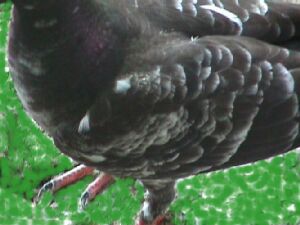
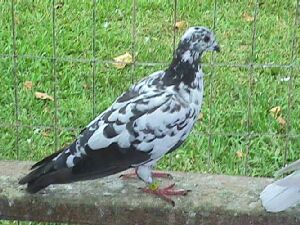
A young Spread Tiger before his molt left. On the right is the same bird as it
completes its molt. Note the difference.
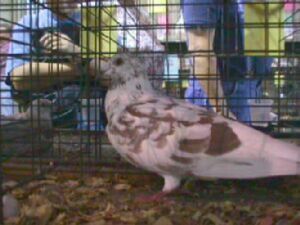
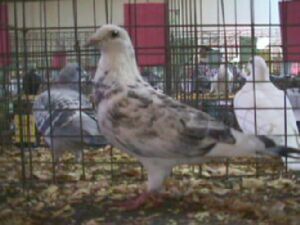
Red Tiger Grizzle on the left, Blue check Tiger on the right.
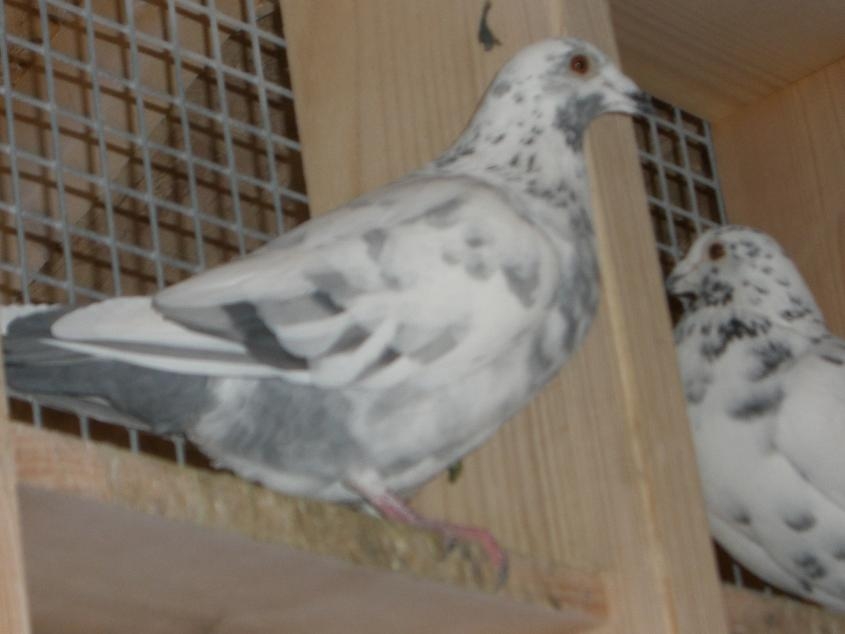
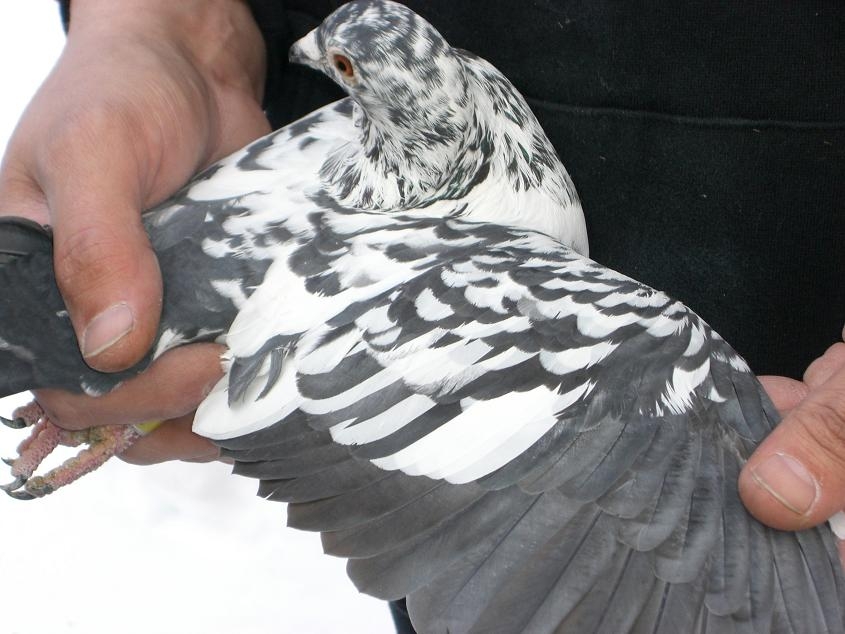
Peter Legowski's dilute blue bar tiger grizzle on the left; on
the right is one of his spread blue tiger grizzles. Peter's family of very
nice tiger grizzles go back to when he was a kid.
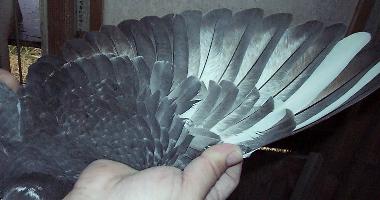
A blue t-pattern Undergrizzle wing by my friend Steve Souza
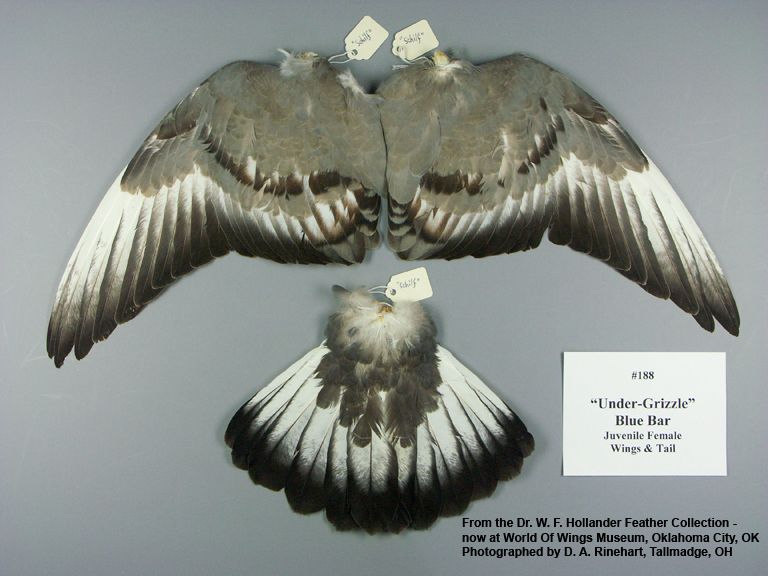
The above photo was taken by David A. Rinehart. It is a photo of one of our beloved friend's, feather collection, the late Dr. Willard F Hollander. This feather collection is on display at the World Of Wings Museum, Oklahoma City, OK.. David was kind enough to send it along with his personal comments on this mutation known as Undergrizzle. I will include his comments as they were written in hopes that they will shed light on the difference between Undergrizzle and another very similar mutation known as Flash. Here is what Dave wrote.
"Attached is a picture of Undergrizzle. I thought I would pass this on to the group, as I canít recall anyone posting a decent picture of Undergrizzle. I included a note on the picture that the shafts of the tail feathers are pigmented. This is significant, as the shafts of Flash are NOT pigmented. Gibson did not recognize this difference till WFH noted it, and then it took him a few years to admit that there was a difference between the two factors.
And Hollander was adamant that Flash be called FLASH and
not flash grizzle. Flash is not a grizzle, but evidently part of a pied
pattern; WFH thought it is part of the gazzi/recessive white/pencil/
Here are more of Dr. Hollanders grizzle collection thanks
to David Rinehart.
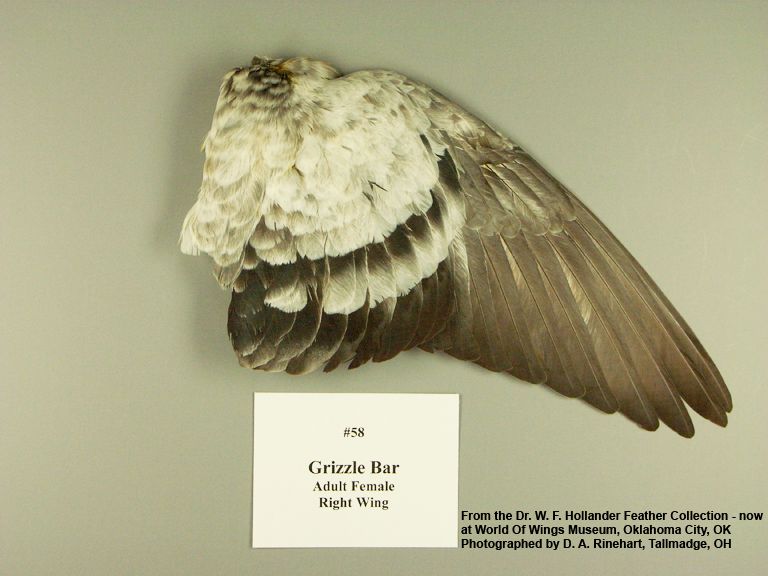 Grizzle in Bar pattern
Grizzle in Bar pattern
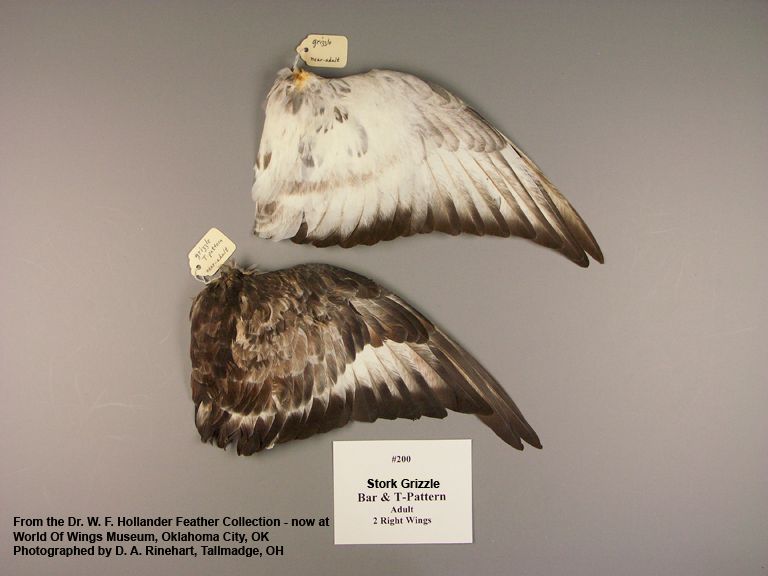 Stork Grizzle in both Bar and T-Pattern
Stork Grizzle in both Bar and T-Pattern
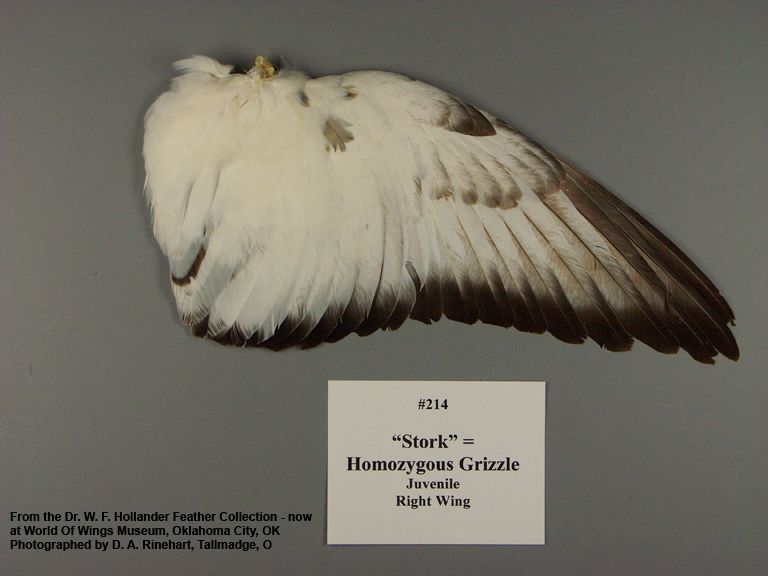 Stork grizzle when from homozygous Grizzle
Stork grizzle when from homozygous Grizzle
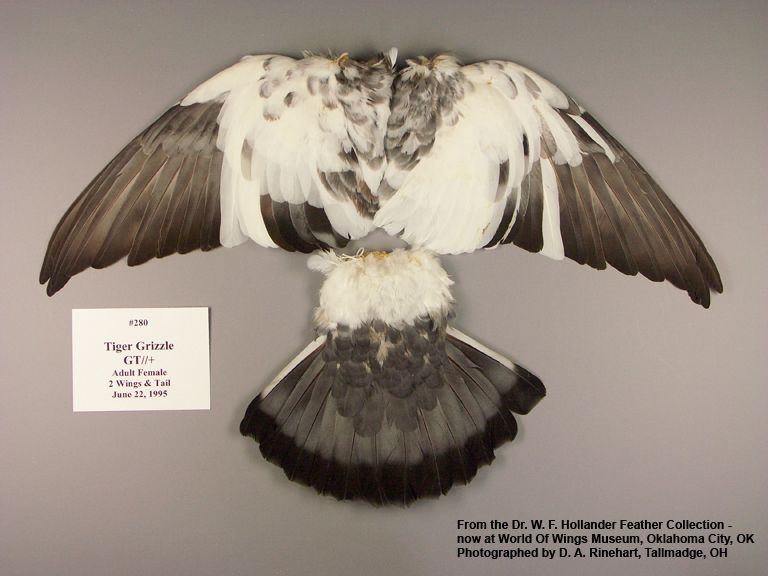 Tiger Grizzle (note does not effect the tail)
Tiger Grizzle (note does not effect the tail)
Copyright 1999 by Ronald Huntley.
Permission is granted to download
or copy for non-commercial individual use
only.
The author retains all other rights under copyright.
Ronald R. Huntley
Web Page Designer
Duncan, SC. 29334
phone: (864) 249-0276